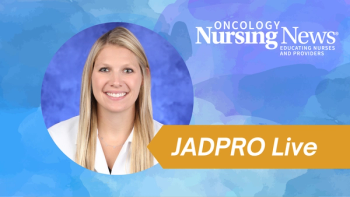
- October 2018
- Volume 12
- Issue 8
On the Cutting Edge: The Latest Procedures in Postmastectomy Reconstruction and Care
Nurses share the latest procedures in postmastectomy reconstruction and how to support women in recovery.
Penny Banks, MSN, BSN, RN
Myra DiGange, BSN, RN, hospital admin­istrator at St. Charles Surgical Hospital in New Orleans, Louisiana, never imag­ined she would one day become a patient in her own hospital. Yet after a diagnosis of
DiGange chose to undergo an advanced microsurgical technique called deep inferior epigastric perforator (DIEP) flap surgery imme­diately after her mastectomy. In this proce­dure, surgeons use the patient’s own abdominal tissue to reconstruct natural looking breasts. As in DiGange’s case, many patients are able to have DIEP surgery at the same time as the mastectomy, eliminating the need for separate procedures.
DIEP breast reconstruction surgery has replaced older breast reconstruction techniques, such as transverse rectus abdominis (TRAM) and Latissimus flaps. It improves on prior techniques by using fat from below a patient’s belly button and avoiding cutting muscles from the abdominal wall.
“With DIEP, patients don’t need implants and the procedure preserves a patient’s abdominal muscle function and strength,” said Penny Banks, MSN, BSN, RN, clinic director at The Center for Restorative Breast Surgery. In the long term, DIEP flap surgery can decrease risk for hernias and abdominal weakness.
There is also what many women would consider an additional benefit. When surgeons relocate the living tissue from below a patient’s belly button, they effectively give patients a “tummy tuck,” Banks says.
In recent decades, the field of breast recon­struction following mastectomy has rapidly evolved, along with the role nurses play in caring for patients. Although they are more common now, reconstructive surgeries are not simple and require careful follow-up both by the clin­ical team and caregivers, who help the patients at home.
Recovery can take weeks, and patients must be prepared for that. After her DIEP flap surgery, for example, DiGange’s care team recommended care­giver support for a week to 10 days after surgery and they advised her to avoid strenuous activity for 4 to 6 weeks.
DiGange appreciated how nurses involved her family in the care experience and discussed ways that her husband could help during her recovery at home. “They showed my husband how to look for signs of infection and to help care for my surgical drains, which were placed to prevent blood and lymphatic fluid from building up at the surgical site,” says DiGange. She also appreciated one nurse’s special sensitivity. “My elderly mom gets anxious at the sight of bruises, so my nurse made sure everything was covered and out of sight when my mom came to visit,” she says.
DiGange who is now cancer free, is looking into nipple reconstruction as a next possible step. This would require further surgery. Alternatively, she is considering working with a tattoo artist who comes to the Center and inks areolas and nipples that are realistic and 3-dimensional. She is grateful for the support she has had so far along the journey, especially from her nurses.
Breast Reconstruction Resources
BREAST360
Breast360, a site maintained by the American Society of Breast Surgeons Foundation, offers information, videos, and free counseling.
BREAST RECONSTRUCTION AFTER MASTECTOMY
The National Cancer Institute provides fact sheets in different languages.
BREASTCANCER.ORG
Breastcancer.org provides information on breast reconstruction, available support, insurance coverage issues, and more.
LIVING BEYOND BREAST CANCER
Living Beyond Breast Cancer offers free webinars on new treatments and clinical trials and webinars for healthcare professionals who work with patients with breast cancer.
FORCE
Facing Our Risk of Cancer Empowered (FORCE) is a resource for patients and nurses who want to learn more about hereditary breast cancer, and it also has a section covering the basics of reconstruction.
CENTER FOR RESTORATIVE BREAST SURGERY
Find videos from surgeons on commonly asked questions about reconstruction surgery, animated demonstrations of the surgeries, before and after images, and more.
DIEPCJOURNEY
Terri Coutee of Tucson, Arizona, became an educator and breast cancer patient advocate after undergoing a mastectomy and breast reconstruction. She maintains a blog, DiepCJourney; a nonprofit organization, DiepCFoundation; and a Facebook group, DiepCJourney—Breast Reconstruction After Mastectomy, to provides education and resources to empower patients with information about options in breast reconstruction after mastectomy.
PEER COUNSELING
The American Cancer Society’s Reach to Recovery program matches trained breast cancer survivors to people living with breast cancer. Through phone calls and face-to-face visits, women are paired with others who are in their age group and have undergone a similar diagnosis. Cancer Support Community performs a similar service. CancerCare also matches patients with survivors in support groups, and offers counseling and financial resources as well.
NEW RECONSTRUCTION TECHNIQUES
Generally, breast reconstruction surgery involves implants or autologous tissue (flap) reconstruc­tion using a woman’s own body tissue to rebuild the breasts, says Banks. In addition to the DIEP flap surgery, the world-renowned Center for Restorative Breast Surgery offers advanced breast reconstructive techniques pioneered by surgeons at the Center including the Superior Gluteal Artery Perforator (SGAP), APEX Flap, Stacked Flap, and BODY LIFT Flap breast reconstruction procedures.
The SGAP procedure transplants living unwanted excess fat from the upper hip and buttocks to the chest. Banks describes APEX Flap recon­struction as a microsurgical technique that is a refinement of the DIEP surgery. It involves rear­rangement of blood vessels to improve flap and donor site surgical outcomes.
The Stacked Flap procedure provides a solution for thin women who need reconstruction of a single breast. The procedure allows excess living fat to be transplanted from a patient’s lower abdomen and layered to recreate a new breast.
The BODY LIFT Flap procedure takes tissue from both the stomach and the buttocks, with the added benefit of reshaping and lifting the body.
Because the Center has an international reputa­tion as a leader in breast reconstruction surgery, Banks says the hospital often treats patients from around the world. Patients often undergo pre-op testing in their hometowns before traveling to New Orleans.
“Patients typically stay 3 nights in the hospital post surgery and then remain in the area for a week after for their post-op appointment,” Banks says. “We also follow up with them after they have returned home, to check on their recovery.”
Banks says a significant part of the Center’s intake process is educating patients on what each surgical procedure entails and helping them make informed decisions. In addition to patients who are undergoing reconstructive surgery for the first time, Banks says her center sees an average of 10 patients per week who have had failed or botched reconstructive surgeries at other surgery centers. Doctors who perform recon­structive surgeries infrequently may not be as skilled, she says, or may not know about some of the newer procedures available.
“So many of the women were never told about the various reconstructive options that were available to them,” Banks says. “Patients should always feel comfortable asking their surgeons questions, inquiring about how many reconstructive surgeries they have done, and asking to see before and after photos.”
BEFORE, DURING, AND AFTER SURGERY
Jennifer Wood, BSN, RN, CBCN, is 1 of 2 oncology nurse navigators at the Medical University of South Carolina (MUSC) Hollings Cancer Center in Charleston. A nurse at MUSC for the past 20 years, Wood has spent the past nearly 8 years at Hollings assisting women with breast cancer from diagnosis through treatment.
“I always tell patients that breast recon­struction is a process, not a procedure,” Wood says. “It starts with surgery for breast cancer and may continue with subsequent procedures tailored to each patient’s needs and goals.”
Wood says the staff at Hollings uses a
“We look at factors such as whether the patient is a smoker and might need a smoking cessation program, since smoking can cause major issues with wound healing after breast reconstruction,” Wood says. “Other patients may be experiencing anxiety or depression and might benefit from meeting with one of our behavioral health specialists.”
In addition to addressing a patient’s concerns before surgery, Wood says nurses send patients home after surgery with a detailed care plan that addresses challenges they might face during their recovery.
“We talk to patients about having someone who can help with things such as washing their hair or providing transportation since they won’t be able to drive or raise their arms overhead for several weeks after surgery,” Wood says. “For patients who live alone, we also share strate­gies such as moving commonly used household items to a lower level before surgery.”
Katie McCamey, BSN, RN, CBCN, breast cancer nurse navigator at the Sarah Cannon Cancer Institute at Medical City Dallas Hospital in Texas, sees a big part of her job as rein­forcing the education patients receive from their surgeons regarding breast reconstruction.
“There’s no one-size-fits-all approach when it comes to breast reconstruction,” McCamey says. “Part of choosing the right procedure depends a lot on a patient’s comorbidities such as obesity, diabetes, etc.”
In addition to working to connect patients with resources within the hospital, McCamey strives to educate patients on outside resources that can help them in their journey. She warns patients to rely on credible sources only. “I tell patients to stay away from Dr. Google and only go to trusted medical websites that offer evidence-based information.”
Instead, she points patients to support groups. “There are a lot of breast cancer support groups out there, and patients say it really helps to talk with someone who has been through the experience,” McCamey says.
A support group can also provide comfort to women who worry about their cancer returning or who have concerns about multiple surgeries. McCamey says she often hears from women who worry about how they will feel after a mastectomy and the pros and cons of not undergoing reconstruction surgery.
“It’s not uncommon for women to go through several breast reconstruction procedures in order to achieve optimal results,” McCamey says. “Some women also choose to undergo nipple reconstruction, while others decide not to have reconstruction at all.”
McCamey says nurses also play an important role in helping patients form an action plan that can help them as they recover from surgery. “There’s a great organiza­tion,
Jill Tibbetts, PA-C, a physician assistant in the MUSC Department of Surgery’s Division of Plastic and Reconstructive Surgery, says patients undergoing breast reconstruction surgery often ask about how the surgery will affect their lives. “They want to know how a mastectomy and reconstruction will impact their relationships, how many proce­dures they might need, and when they can get back to a new normal,” she says. “Nurses are such an integral part of the entire process and provide patients with valuable infor­mation and support on what to expect at each stage.”
Articles in this issue
about 7 years ago
Rebuilding the Breastabout 7 years ago
Understanding Multigene Testing for Breast Cancerabout 7 years ago
MDM2 Inhibitor May Improve Response in Acute Myeloid Leukemiaabout 7 years ago
Bypassing the SICU May Improve Patient Outcomesabout 7 years ago
Ketamine May Benefit Those With Difficult Pain From Ovarian Cancerabout 7 years ago
Dressing for the Seasonabout 7 years ago
Recognize and Report Itabout 7 years ago
Camping for Health

















































































